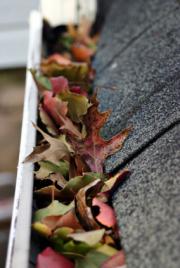As the leaves change and the days get shorter, take the time this autumn to prepare for the oncoming cold weather. Ready the furnace for the months of work it will have ahead, and clean out the fireplace. Test them both to ensure they’ll be working when you need the heat. Don’t wait until it’s snowing to clear out your gutters. With upkeep in the fall, you’ll have peace of mind in the winter and more time to hibernate.
Inside The House
Heating System Checkup
Be sure to change the air filter in your furnace and check its efficiency before the cold weather begins. Call in an HVAC contractor to test the heating output and give the system a tune-up. This technician can also check for and correct possibly hazardous carbon monoxide levels generated by your heating system. Stock up on several air filters for the winter, and change them every month. If you don’t have a programmable thermostat, purchase one for the system to help lower your energy costs.
After your furnace has been tuned up to its maximum efficiency, take a moment to inspect your heating ducts and vents. Dust them off and clear away anything that may have gotten into them over the summer. Then check your windows for any leaks that may compromise your heating efficiency. If you feel cold air coming in, purchase a plastic sealing kit from the hardware store and place the plastic around the window to keep the heat from escaping. Be sure to check your doors as well, and fix their weather-stripping if needed.
Check The Fireplace & Chimney
Most chimney sweeps recommend an annual sweeping, but depending on how often you use the fireplace, you might be able to wait on a full sweep. But if you will be using the fireplace often, call a chimney sweep for an inspection. For further information, read the Chimney and Woodburning Fireplace Safety guide.
Hopefully you will have your older, seasoned firewood now ready for use after sitting for the spring and summer. It’s recommended to keep the firewood at least 30 feet from the house and covered. Seasoned wood is best for fires, as it burns cleaner and longer.
Review Home Fire Safety
The introduction of the heating season brings new potential for fire hazards, so take a moment to review fire safety in your home. Check and replace fire extinguishers if necessary, and change the batteries in your smoke detectors. Also go over the home fire evacuation plan with your family.
Outside The House
The Gutters
It’s best to inspect and clean the gutters a few times during the fall, especially if there are many leafy trees around your house. If gutters remain clogged, water will spill over them and onto the ground next to the foundation, which may cause damage to the foundation. Gutters and downspouts should be kept clean and should direct water away from the foundation, as well as from walkways and driveways, so that they do not become slippery or icy.
Yard Maintenance
The orange, yellow, and brown colors of the autumn leaves don’t look as nice on the ground as they do on the trees. Rake the leaves into piles and scoop them into yard waste bags. Most areas have ordinances about burning leaves, so check with your local area government first. When sweeping the leaves off your patio, don’t forget to clean, pack up, and store any patio furniture for the winter. Disconnect garden hoses and, if practical, use an indoor valve to shut off and drain water from pipes leading to outside faucets. This reduces the chance of freezing in the section of pipe just inside the house.
In The Garage
It is recommended that you empty out unused fuel from any gas-powered equipment stored in the garage, such as a lawnmower, because sediment can build up and clog the fuel lines. Store gasoline in tanks out of children’s reach and have it ready for use in your snowblower or emergency generator, if need be.
Test Your Emergency Generator
It’s a good idea to have an emergency generator if you live in an area that sees a lot of ice storms, as these are a major cause of blackouts during the winter. So if you have one, haul it out and give it a test run to see if it is in good working order. Make sure you never run the generator in any enclosed space – like your garage – as it will present a carbon monoxide hazard.
Information from State Farm Insurance: Visit www.StateFarm.com for more details.
 Lubricate locks and hinges: Creaky hinges and sticking locks can spook you at exactly the wrong moment, so make the rounds with a can of WD-40. It’ll clean and lubricate metal mechanisms in one shot.
Lubricate locks and hinges: Creaky hinges and sticking locks can spook you at exactly the wrong moment, so make the rounds with a can of WD-40. It’ll clean and lubricate metal mechanisms in one shot. Quiet kitchen cabinets: Before the Fall is over, your kitchen will soon be bustling with holiday dinners, baking projects, and house guests, so don’t let little annoyances get in the way of big plans. Clean and lubricate drawers and hinges on kitchen cabinets, and replace any catches that no longer catch.
Quiet kitchen cabinets: Before the Fall is over, your kitchen will soon be bustling with holiday dinners, baking projects, and house guests, so don’t let little annoyances get in the way of big plans. Clean and lubricate drawers and hinges on kitchen cabinets, and replace any catches that no longer catch.